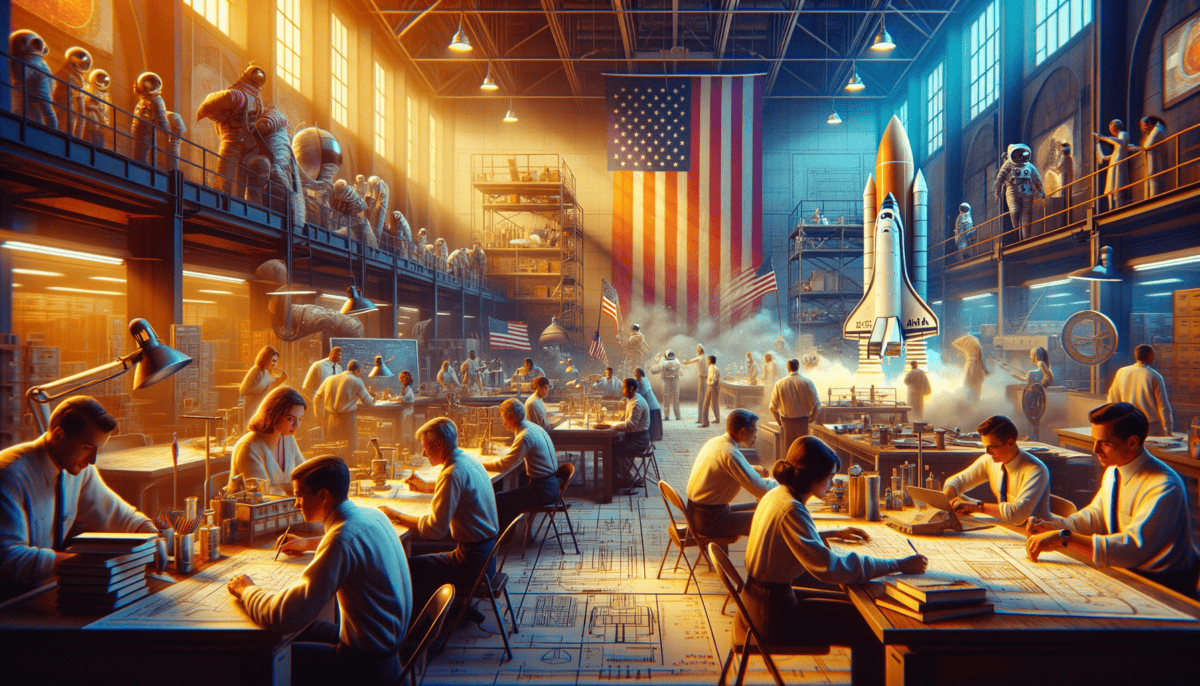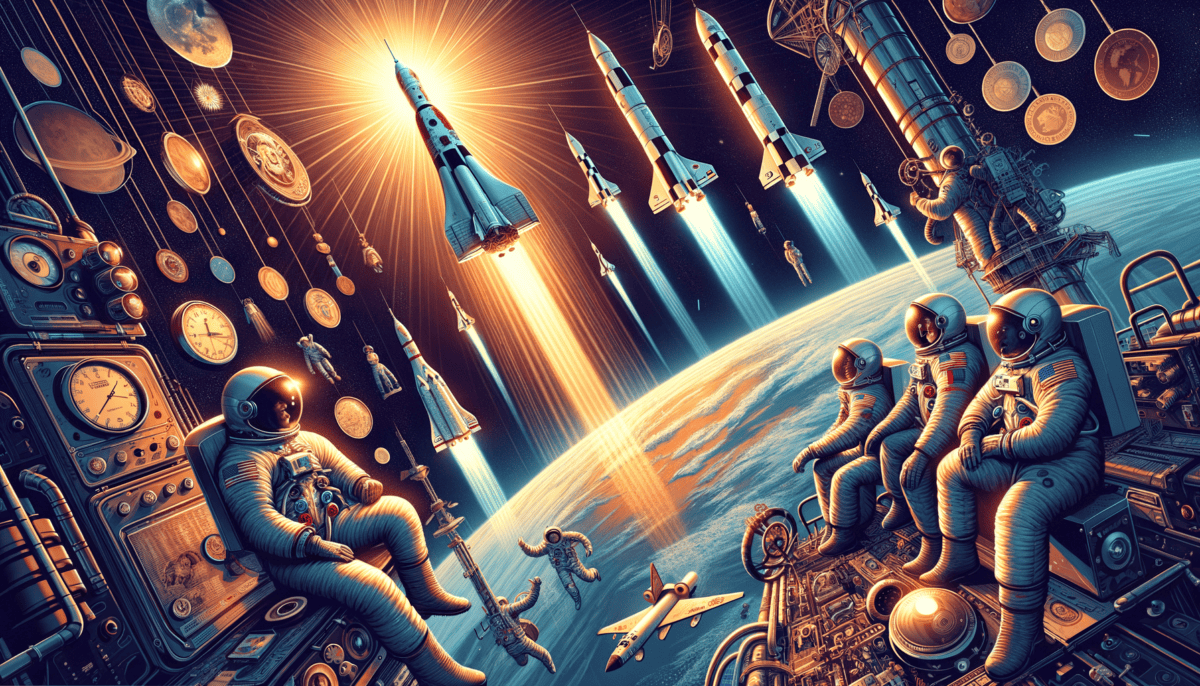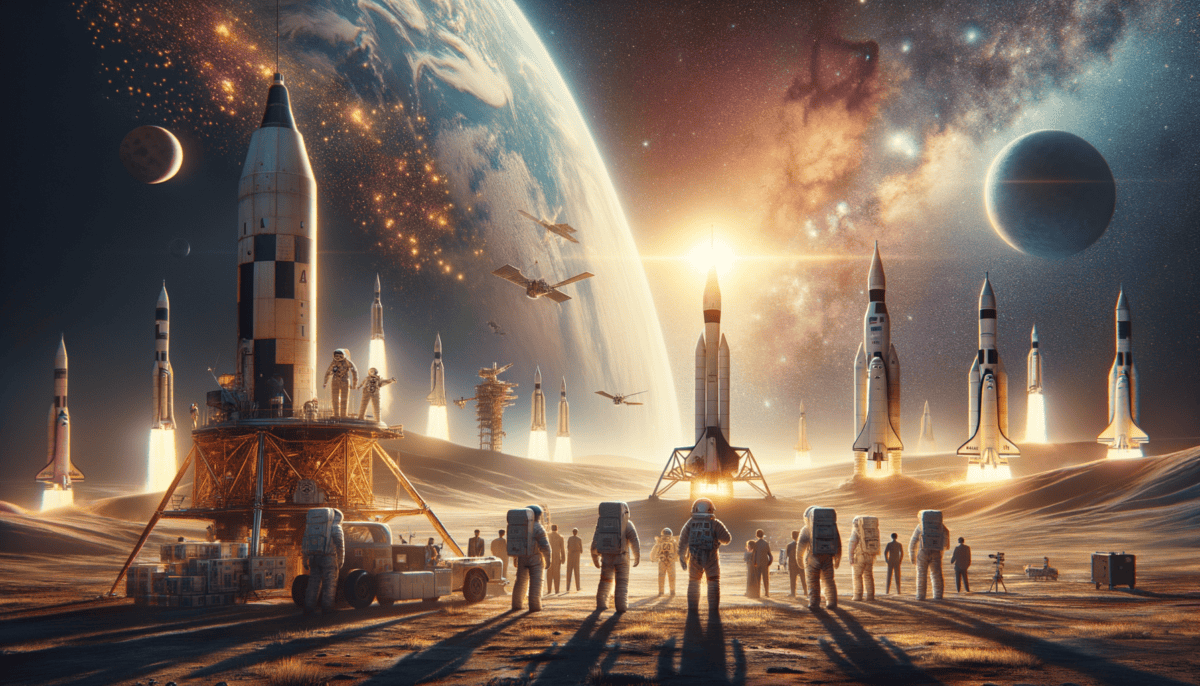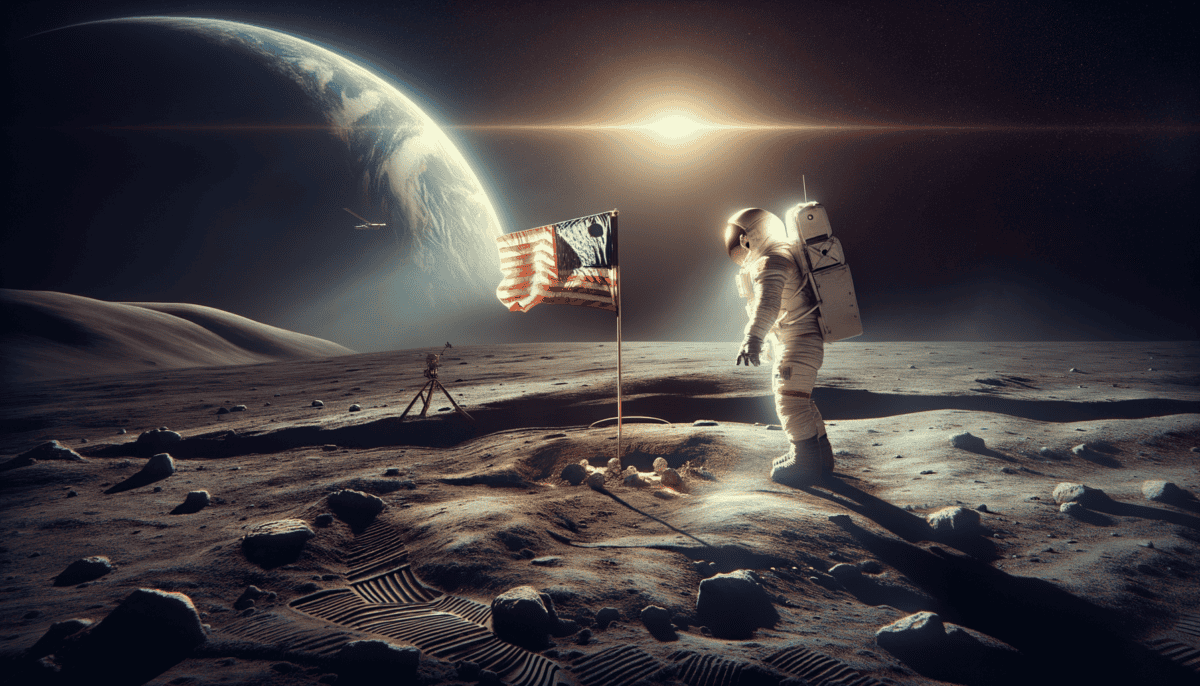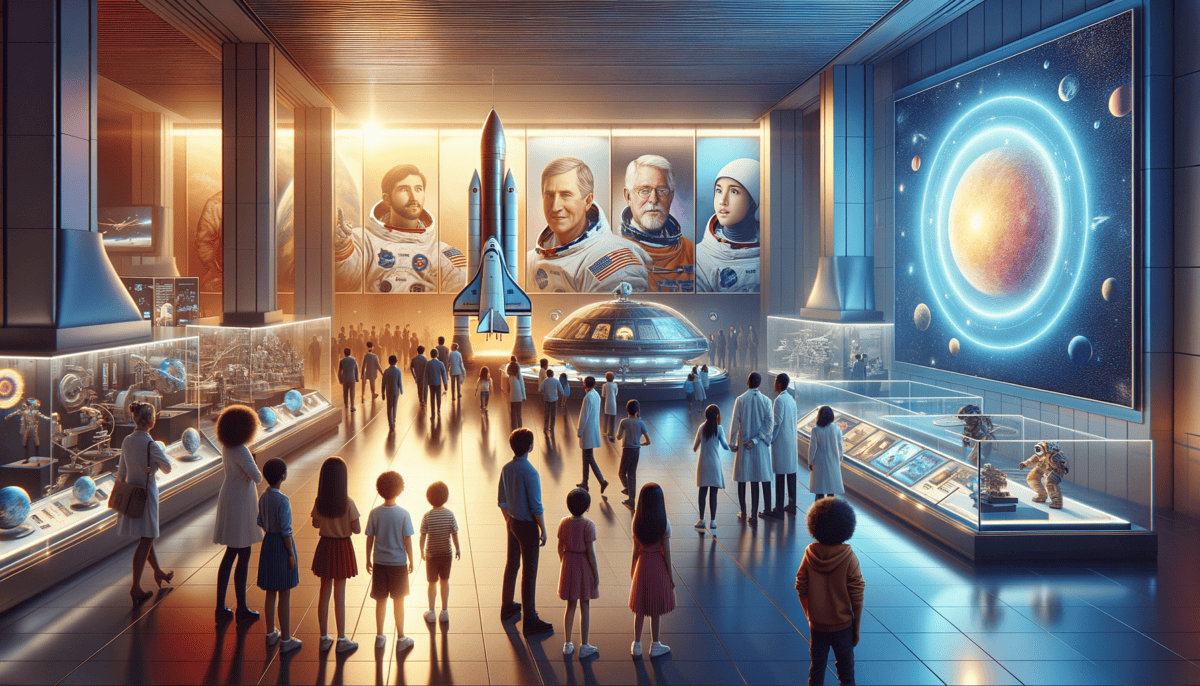The Sky Awakens
Tommy pressed his nose against the cold window, his eyes fixed on the night sky. The stars twinkled like tiny diamonds, but tonight was different. Somewhere up there, a small metal ball was racing around Earth faster than anything before.
"Daddy, can we really hear it beeping?" Tommy asked, turning to his father who sat by the radio.
"Shhh," his father whispered, adjusting the dial carefully. "Listen…"
beep… beep… beep…
The strange sound filled their living room. It was October 4, 1957, and the world had changed forever. The Soviet Union had just launched Sputnik 1, the first human-made object to orbit Earth. ️
"But what does it do?" Tommy asked, climbing onto his father's lap.
"It flies around Earth, son. The Russians built it to show they could reach space first." His father's voice was serious. "Now everyone's talking about it."
And they were. All across America, people looked up at the night sky, wondering about the tiny spacecraft zooming overhead. Some were scared, others excited, but everyone knew something big was happening.
Dr. Sarah Martinez sat at her desk at NASA, surrounded by papers covered in numbers and drawings. She hadn't slept much since hearing about Sputnik. ✏️
"We need to catch up," she said to her colleague, Dr. James Wilson. "The space race has begun."
"But how?" James asked, running his hands through his gray hair. "We're years behind!"
Sarah smiled and held up a drawing. "We start here. We build our own satellites. Then we aim higher – much higher."
• Satellite: An object that flies around Earth
• Orbit: The path something takes around Earth
• Space Race: The competition between America and Russia to be best in space
Back in Russia, Dr. Sergei Korolev watched his creation through a powerful telescope. He had worked for years to build Sputnik, and now it was flying high above Earth. But he knew this was just the beginning.
"We must go further," he told his team. "This is only the first step."
The newspapers were filled with pictures of Sputnik. Teachers brought radios to school so students could hear the beeping. Everyone talked about space and rockets and what might come next.
Tommy's teacher, Miss Robinson, hung a big map on the classroom wall. She drew Sputnik's path around Earth with a red marker.
"Children," she said, her eyes bright with excitement, "we're living in a special time. Humans have finally reached into space. Just think about what might happen next!"
That night, Tommy couldn't sleep. He kept thinking about Sputnik flying overhead. He grabbed his notebook and started drawing rockets and stars. ⭐
"Maybe someday," he whispered to himself, "I'll help build something that flies even higher than Sputnik."
Sarah stayed late at NASA again, working on new designs. She knew the race to space had just started. America would need to work harder than ever before.
"We'll need the best scientists," she said to herself. "The best engineers. The best astronauts."
The word 'astronaut' was new – it meant someone who would travel in space. Sarah wondered who would be brave enough to volunteer for such a dangerous job.
Outside her window, the stars continued to shine. Somewhere up there, Sputnik kept beeping its simple song, telling the world that the space age had begun. The sky had awakened, and nothing would ever be the same.
Race Against Time
The room buzzed with excitement as President Eisenhower stood before the cameras. “Today, we create NASA – the National Aeronautics and Space Administration.”
Tommy watched the announcement on TV with his class. “What’s NASA, Miss Robinson?” he asked.
“It’s America’s new space team,” she explained. “They’re going to help us catch up in the space race!”
At NASA headquarters, Dr. Sarah Martinez clapped along with her colleagues. “Finally!” she said to Dr. Wilson. “Now we can really get to work.”
“And we’re starting with Project Mercury,” Dr. Wilson replied, spreading blueprints across the table. “We’re going to send the first American to space!”
The search for astronauts began right away. They needed brave pilots who weren’t afraid to try something new. Hundreds of test pilots got letters asking if they wanted to fly to space.
• To be very brave
• To be a great pilot
• To be super healthy
• To be good at solving problems
• To stay calm when things get scary
“These will be the Mercury Seven,” Sarah explained to her team. “Our first astronauts!”
Alan Shepard was one of the pilots who got picked. He stood tall as he tried on his silver space suit for the first time.
“How does it feel?” asked the suit technician.
“Like America’s future,” Alan replied with a smile.
The training was harder than anything the astronauts had done before. They rode in spinning chairs until they felt dizzy. They practiced floating in pools to get ready for zero gravity. They learned about their spacecraft inside and out.
Tommy brought newspaper clippings about the astronauts to school every day. “Look!” he’d say, showing his friends pictures of the Mercury Seven. “They’re going to fly higher than anyone ever has!”
But it wasn’t easy. The first rockets kept exploding during tests. Each boom made Sarah worry more.
“We have to work faster,” she told her team. “The Soviets aren’t waiting for us to catch up.”
One night, Tommy found his father looking worried while reading the newspaper.
“What’s wrong, Dad?”
“Some people think we’re spending too much money on space,” his father explained. “They don’t understand why it’s important.”
“But it is important!” Tommy said. “Miss Robinson says space helps us learn new things. And if we don’t try, we’ll never know what’s up there!”
His father smiled. “You’re right, son. That’s exactly why we have to keep trying.”
At NASA, the work continued day and night. Engineers built better rockets. Scientists solved tough problems. The astronauts trained harder than ever.
Sarah stayed late again, checking calculations. Through her office window, she could see the massive rocket on the launch pad, gleaming under bright lights.
“Soon,” she whispered. “Very soon.”
The Mercury capsule was tiny – just big enough for one person. But it had to be perfect. It would carry precious cargo: the first American astronaut in space.
“What if something goes wrong?” someone asked during a meeting.
“Then we fix it,” Sarah answered firmly. “We keep trying until we get it right. That’s what Americans do.”
The whole country watched and waited. In schools, children built rocket models. In backyards, families set up telescopes. Everyone wanted to be part of the great adventure.
Alan Shepard practiced climbing into his capsule one more time. “Freedom 7,” he called it – a perfect name for America’s hope to reach the stars.
“Ready?” asked the technician.
Alan nodded, his face serious behind the helmet visor. The real launch was getting closer every day. America was ready to take its first step into space.
Breaking New Ground
The morning of April 12, 1961, started like any other. But everything changed when the radio crackled with amazing news.
“The Soviet Union has done it!” the announcer said. “Cosmonaut Yuri Gagarin has become the first human in space!”
Tommy rushed to tell his parents. “Someone’s really up there! In space!”
At NASA, Sarah Martinez paced in her office. “We have to move faster,” she said to Dr. Wilson. “The Soviets beat us again!”
But good news was coming. Just three weeks later, Alan Shepard sat in Freedom 7, ready to go.
“3…2…1…LIFTOFF!”
The rocket roared to life. Flames burst from below. Freedom 7 rose into the sky, carrying the first American to space!
“What a beautiful sight,” Alan said as he looked at Earth from above. His flight lasted 15 minutes, and he flew 116 miles high.
Tommy watched it all on TV with his class. Everyone cheered when Alan landed safely in the ocean.
“Now it’s John Glenn’s turn,” Sarah told her team. “He’s going to orbit Earth!”
John Glenn trained extra hard. He would be in space much longer than Alan. He had to learn even more about his spacecraft, Friendship 7.
“Why did you name it Friendship 7?” Tommy’s teacher asked during their class discussion.
“Because space exploration should bring people together,” she explained. “It’s about friendship between all people on Earth.”
• Orbit: Going around Earth in a circle
• Spacecraft: A vehicle that flies in space
• Cosmonaut: What the Soviets called their space travelers
• Astronaut: What Americans called their space travelers
On February 20, 1962, John Glenn climbed into Friendship 7. His heart was racing with excitement.
“Godspeed, John Glenn,” the radio crackled.
Up he went! Higher and higher until Earth looked like a big blue marble. John Glenn orbited Earth three times!
“The view is tremendous!” he radioed back. “I can see the whole coast of Florida!”
Something scary happened during the flight. Warning lights showed there might be a problem with the heat shield. But John stayed calm. He trusted his training and the NASA team.
Sarah and her team worked quickly to solve the problem. “Everything will be okay,” she assured Mission Control. “The shield is strong.”
She was right! John Glenn landed safely after nearly five hours in space. He became an American hero! ♂️
Tommy wrote about it in his school journal: “Today I watched a man fly around Earth THREE TIMES! Maybe someday I can do that too!”
More flights followed. Each one taught NASA something new. They learned how to eat in space, how to sleep floating around, and how spacecraft worked better.
“Space is changing everything,” Sarah said one evening, looking at the stars. “Just think what we’ll do next!”
The Space Race was getting more exciting. Both America and the Soviet Union kept reaching higher. They were learning that space was big enough for everyone.
Scientists invented new things to help astronauts: special food, better cameras, and stronger materials. Many of these inventions helped people on Earth too!
One night, Tommy’s dad pointed to the stars. “See that moving light? That might be a spacecraft up there right now!”
Tommy smiled. The space above didn’t seem so far away anymore. It was becoming a place where brave people could go and explore.
Reaching for the Moon
The room fell silent as President Kennedy appeared on TV. Tommy and his classmates leaned forward in their seats.
“We choose to go to the Moon!” the President declared. “Not because it is easy, but because it is hard!”
Sarah Martinez hurried through NASA’s halls. “This changes everything,” she told Dr. Wilson. “We need bigger rockets, better spacesuits, and special Moon landing practice!”
NASA created a new program called Apollo. It would take astronauts all the way to the Moon!
“How will they get there?” Tommy asked his teacher.
“They’ll need a very special rocket,” she explained. “The biggest one ever built!”
Engineers worked day and night designing the Saturn V rocket. It would be as tall as a 36-story building!
Meanwhile, astronauts trained harder than ever. They had to learn many new things:
• How to land on the Moon
• What to do if something goes wrong
• How to collect Moon rocks
They practiced in big pools of water to feel what floating in space was like. ♂️
“It’s not easy,” astronaut Jim Lovell said. “But nothing worth doing ever is!”
Tommy watched a test flight on TV. The rocket was so powerful it shook the ground for miles!
“My windows rattled!” his mom said. “Can you imagine being on top of that?”
The astronauts’ families worried about their safety. Sarah worked extra hard to make everything as safe as possible.
“We test everything three times,” she explained to a group of worried wives. “Then we test it again!”
One day, Tommy’s class got to build model rockets. “Just like the real scientists!” he said proudly.
Scientists invented new tools for the Moon mission. They made special cameras that could work in space and clothes that could protect astronauts from extreme temperatures.
“Look at this new material,” Sarah showed her team. “It can keep astronauts safe in temperatures from -250° to +250°!” ❄️
The whole world watched as Apollo missions tested everything. Each flight went a little further into space.
“It’s like climbing a very tall ladder,” Tommy’s dad explained. “You have to go up one step at a time.”
Astronaut families moved to Houston, Texas, to be near the space center. Their children went to school together and became good friends.
“My dad’s going to the Moon!” one girl told Tommy’s class during show-and-tell.
Every successful test brought them closer to their goal. But there were hard times too. Sometimes things didn’t work right, and the scientists had to start over.
“That’s how we learn,” Sarah told her team after a failed test. “Each problem we solve makes us stronger.”
Finally, after years of work, NASA was almost ready. They had built the rockets, designed the spacecraft, and trained the astronauts.
“Soon,” Sarah said, looking at the massive Saturn V rocket, “we’ll be ready to take the biggest step in human history.”
“Do you think we’ll make it?” Tommy asked his dad that night.
“With so many smart people working together,” his dad replied, “I believe we can do anything.”
The Moon glowed brightly in the sky. Soon, if everything went well, people would walk on it for the first time. The dream that started with President Kennedy’s speech was about to come true.
A Giant Leap
The big day was finally here! The mighty Saturn V rocket stood tall against the morning sky. Inside, three brave astronauts – Neil Armstrong, Buzz Aldrin, and Michael Collins – got ready for their historic journey.
“Look how tall it is!” Tommy shouted, pointing at the TV screen. His whole family gathered around to watch.
At NASA, Sarah Martinez checked everything one last time. “All systems are go!” she announced.
The countdown began: “10… 9… 8… 7… 6… 5… 4… 3… 2… 1… LIFTOFF!”
The rocket roared to life! Flames burst from its engines. Slowly at first, then faster and faster, it rose into the sky.
“They’re on their way to the Moon!” Tommy jumped up and down.
For three days, Apollo 11 flew through space. The astronauts sent messages back to Earth about what they saw.
“Earth looks like a beautiful blue marble,” Neil Armstrong radioed.
Finally, they reached the Moon! Michael Collins stayed in the main spacecraft while Neil and Buzz got into a smaller spacecraft called the Eagle.
Tommy could hardly sit still. “When will they go outside?” he asked.
“Soon,” his mom said. “They have to get ready first.”
Neil Armstrong put on his spacesuit. He carefully climbed down the ladder. The whole world held its breath.
Then, Neil stepped onto the Moon’s surface! “That’s one small step for man, one giant leap for mankind,” he said.
At NASA, Sarah wiped happy tears from her eyes. “We did it!” she whispered.
Buzz Aldrin joined Neil on the Moon. They planted an American flag and collected Moon rocks. They bounced around in the low gravity, taking pictures and doing experiments.
“It’s like they’re dancing!” Tommy laughed. The astronauts seemed to float with each step.
People all over the world watched on TV. For a few hours, everyone forgot about their differences. They were all just humans, amazed by what other humans could do.
“Look at that, Tommy,” his dad said. “People everywhere are watching this together.”
After exploring for over two hours, Neil and Buzz returned to their spacecraft. They had to get back to Michael Collins and head home.
The trip back was exciting too! The astronauts had to land in the ocean. Ships were waiting to pick them up.
“Welcome home, heroes!” people cheered as the astronauts arrived safely on Earth.
At school the next day, Tommy’s teacher asked everyone to draw pictures of the Moon landing.
“I want to be an astronaut too!” Tommy declared as he drew a picture of footprints on the Moon.
Sarah visited Tommy’s class to talk about the mission. She brought a piece of the special material used in the spacesuits.
“Remember,” she told the students, “when people work together and dream big, anything is possible!”
That night, Tommy looked up at the Moon through his window. It looked different now. It wasn’t just a bright light in the sky anymore. It was a place where humans had walked!
“Goodnight, Moon,” he whispered. “Thanks for letting us visit.” ✨
A New Frontier
After the Moon landing, space exploration changed forever. People saw what humans could do when they worked together.
“Daddy, what happened after we went to the Moon?” Tommy asked one evening, gazing at the stars.
“Something amazing,” his father replied. “Countries that used to compete started working together!”
Sarah Martinez was still at NASA, now teaching new astronauts. “Space isn’t about winning anymore,” she explained to her class. “It’s about learning together.”
One day, Tommy’s class visited a science museum. They saw all kinds of cool inventions that came from the Space Race:
- Special cameras that doctors use to see inside bodies
- Comfortable shoes with special soles
- Better batteries for tools
- Safer car tires
- Water filters that keep drinking water clean
“Wow!” Tommy exclaimed. “Space helped make all these things?”
“That’s right,” the museum guide smiled. “When we reach for the stars, we learn new things that help people on Earth too!” ⭐
Years later, Tommy grew up to work at NASA just like Sarah. He helped plan missions to Mars!
“Remember when we watched the Moon landing?” his mom asked during a family dinner.
“How could I forget?” Tommy laughed. “That’s when I knew I wanted to work in space!”
Now, countries from all over the world send astronauts to space together. They live on the International Space Station, doing experiments and looking down at Earth.
“Look how far we’ve come,” Sarah said at her retirement party. “From racing each other to helping each other.”
“What’s next for space?” Tommy’s daughter asked him one night.
Tommy smiled. “The sky’s not the limit anymore, sweetie. We’re going farther than ever before – together!”
He showed her pictures from the new space telescopes. They could see stars and planets nobody had ever seen before.
“Can I be an astronaut too?” she asked.
“Of course you can!” Tommy hugged her. “Space belongs to everyone now. We all share in the adventure!”
Sarah visited Tommy’s daughter’s school to talk about space. She brought the same spacesuit material she had shown Tommy’s class years ago.
“The Space Race taught us something important,” she told the children. “When we stop competing and start cooperating, there’s no limit to what we can do!”
That evening, Tommy and his daughter sat in their backyard, looking up at the stars. The Moon shone brightly overhead, just as it had on that historic night so many years ago.
“Every time I look up there,” Tommy said, “I remember that anything is possible when people work together.” ✨
His daughter squeezed his hand. “I can’t wait to see what we discover next!”
And so, the journey that began as a race between nations became humanity’s greatest adventure – one that continues today, as we reach for the stars together. ✨


